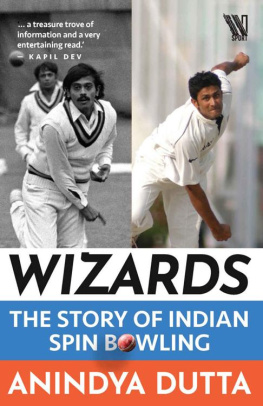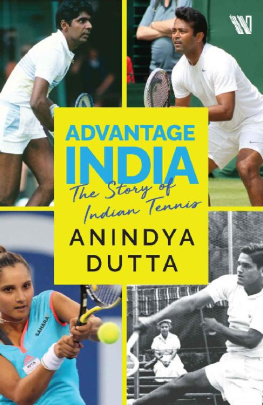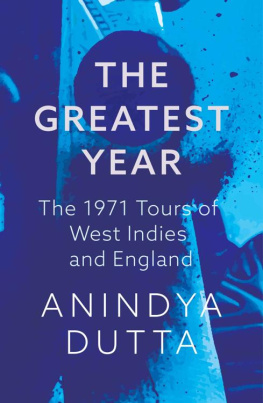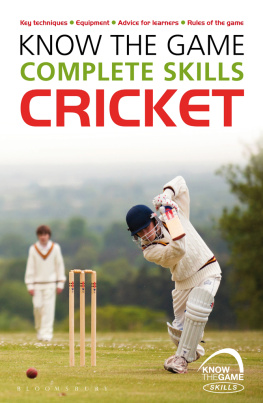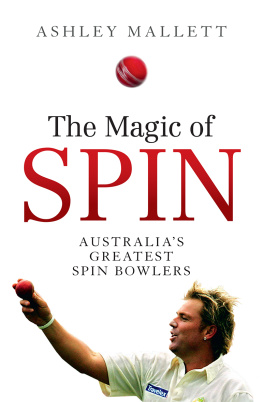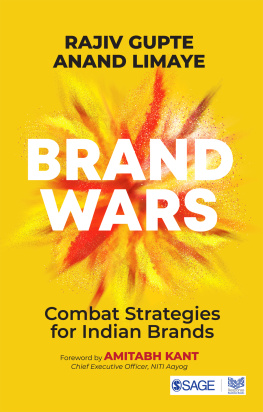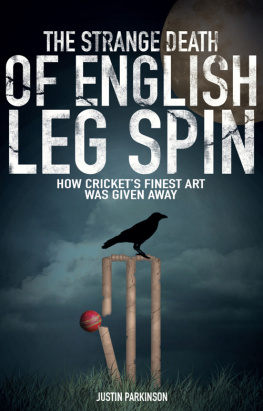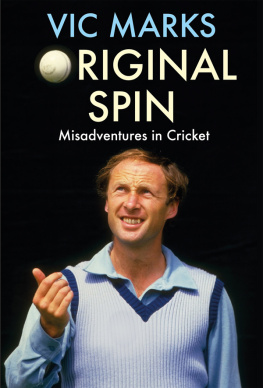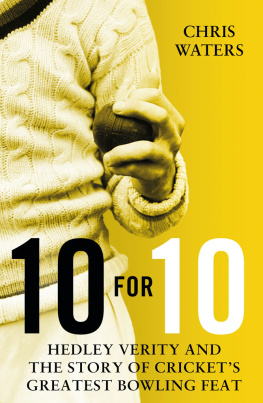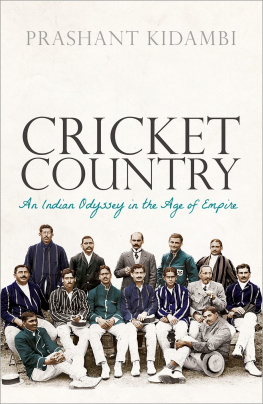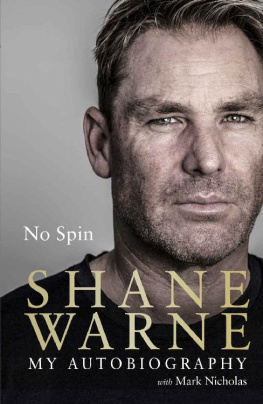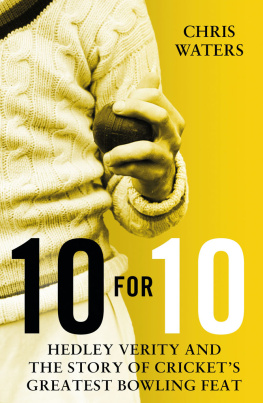WIZARDS
Anindya Dutta is an international banker who has spent the past two and a half decades working in major financial marketsLondon, Hong Kong, Mumbai and Singapore. Besides being a banker, Anindya is also deeply interested in sports history and a sportswriter by vocation.
Anindyas first book A Gentlemans Game (2017) was followed by his widely acclaimed and bestselling account of the greatest bowling spells in the history of cricketSpell Binding Spells (2017) His third book We are the Invincibles, (2019) a fascinating account of Bradmans 1948 teams tour of England also received critical acclaim.
Besides penning books, Anindya is also a columnist for Sportstar, Hindustan Times, ESPN Cricinfo, Cricket Monthly, Cricket Soccer, Roar and Fountain Ink.
Delicately maintaining his work-write balancebanker by day and writer by night, Anindya lives in Singapore with his hugely supportive wife, Anisha and canine daughter, Olu.

First published in Westland Sport, an imprint of Westland Publications Private Limited in 2019
1st Floor, A Block, East Wing, Plot No. 40, SP Infocity, Dr MGR Salai, Perungudi, Kandanchavadi, Chennai 600096
Westland Sport, the Westland Sport logo, Westland and the Westland logo are the trademarks of Westland Publications Private Limited, or its affiliates.
Copyright Anindya Dutta, 2019
ISBN: 9789388754514
All rights reserved
No part of this book may be reproduced, or stored in a retrieval system, or transmitted in any form or by any means, electronic, mechanical, photocopying, recording, or otherwise, without express written permission of the publisher.
This book is dedicated to the two Wizards in my life who make every living moment magicalmy wife Anisha and my canine daughter Olu
Contents

Its always a pleasure to write a foreword for a book on cricket. Ive played the game with a passion and love it immensely, so when Anindya requested me to write this, I agreed right away.
What an achievement it is to write a book detailing the long and rich history of spinners in our country! Diligent research and evocative story telling combine to make this book a truly compelling read.
I have had the rare honour of playing with the four spinning legends of IndiaBishan Singh Bedi, Bhagwat Chandrasekhar, Erapalli Prasanna and Srinivas Venkataraghavan, so it was pleasant to discover a whole section of the book devoted to them.
When I made my Test debut on the tour of Pakistan in 1978-79, the four legends had carried the burden of expectations on their strong shoulders for close to two decades. What had started during Tiger Pataudis captaincy as an idea of packing the team with spinners in reaction to the lack of fast bowling resources in the country, had become a full-fledged spin strategy.
The strategy had an unintended consequence. At all levels of the game, youngsters wanted to emulate the great Indian spinners. There were high class left-arm spinners in many teams and they took wickets by the dozens in first-class cricket, but could not displace Bedi from the Test team. There were Prasanna clones popping up in Ranji matches, but they were not in the class of the genius. Worst of all, in all of Indian cricket, there were no fast bowlers. Not in university cricket, not in club cricket, and certainly not in the first-class game.
When I came on to the scene, I was the first Indian bowler since the legendary Amar Singh and Mohammad Nissar, to bowl consistently fast. When I was picked to tour Pakistan, I was over the moon. Not only was my dream to play for India coming true, I was bowling in tandem with the very stylish and talented Karsan Ghavri, and also rubbing shoulders with the four spin legends.
Bishan Singh Bedi was one of the most respected spinners in the world, and also my captain on that first tour. Notwithstanding the mayhem that the Pakistan batsmen caused on that tour, Bishans attitude as captain and how he thought about the game, left a permanent impression on my young mind. Bishan brought us all together. Like Tiger Pataudi before him, Bishan was a great motivator and gave us the courage and the self confidence that Indians could win against the best teams in the world.
While in Pakistan, it didnt quite work out the way he would have wished, but when he forfeited the ODI at Sahiwal in protest against Sarfraz Nawaz and the Pakistan team destroying the spirit of the game by playing negative cricket to deny India the match, Bishan rose even higher in my esteem. For him, either the game was played in the right spirit, or not at all.
Chandrasekhar was completely unique. There has never been a bowler quite like him. Not only was he difficult to read and face for the opposition, but even for us in the nets. On top of that, his was an inspirational story. How he overcame childhood illness and permanent physical damage to become one of the greatest leg-spinners the world has ever known is a story that is well documented in this book. For those of us who played with him, the contrast of his vicious deliveries coming off the pitch and troubling batsmen, with his unassuming personality and gentle nature without ball in hand, was a source of constant delight.
Then there was Prasanna, oh so classic. I had seen and played against him in domestic cricket before that tour. I was familiar with his guile and control and understanding of the craft of off-spin. His ability to make the ball hang in the air had fascinated me. Sadly, his career was the worst hit by the debacle on the Pakistan tour and he never played for India again.
Finally, there was Venkat. I have rarely seen a more determined cricketer. I had the chance to play alongside Venkat for a few years after the other three retired, and there were lessons to be learnt from that determination. I will always maintain that what happened to him on that flight back from England in 1979, which Anindya describes well in this book, was one of the lowest points of Indian cricket administration.
Before I move on I must mention two more legends of the game who cannot be forgotten. Padmakar Shivalkar and Rajinder Goel were two of the most outstanding spin bowlers I have had the privilege of watching and playing with. It was indeed unfortunate that these two legends of the sport did not get the chance to play for India. They certainly deserved to.
Cricket has changed over the yearsthe formats, the requirements, and hence the bowlers. In India, this change started with the retirement of the four legends.
First came Dilip Doshi, a real thinking bowler. It was my pleasure playing alongside him and also briefly captaining him during his short but impactful career. Shivlal Yadav, who replaced Prasanna in the team was also a very competent spinner. At Melbourne in 1981, when we won a famous victory against a very strong Australian side, I was bowling with a torn thigh muscle, Yadav had a broken toe, and Doshi an instep injury. It is perhaps the only instance in history when a match was won largely by the efforts of three injured bowlers.
Then there was Ravi Shastri, who must be counted among the most remarkable success stories in cricket in relation to his limited inborn talent. Ravi who put in some remarkable performances while we played together, not only at the 1985 World Championship of Cricket in Australia but regularly in Test Cricket as well, showed what hard work and application can achieve in professional sport.
I also played with two remarkably gifted spinners who failed to live up to their potentialLaxman Sivaramakrishnan and Maninder Singh. They were in complete contrast to Ravi, possessing the talent, and yet wasting it.
Next page
